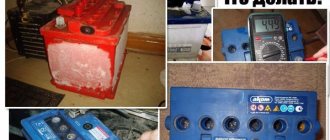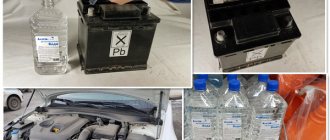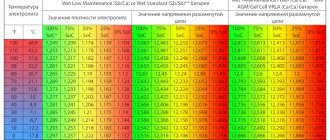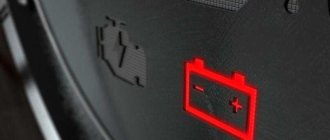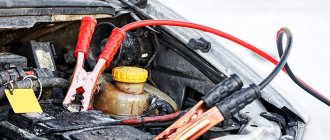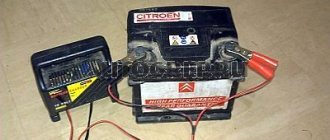Any battery, when put into service, has a limited life. The manufacturer provides one period, but in practice it is usually shorter, which is due to operating conditions, weather influences and other issues.
If the old battery can no longer be restored, you have to buy a new one. And here the motorist has a lot of options. This includes dry-charged batteries. Not everyone knows what they are, how they differ and how to put them into operation correctly.
Dry-charged battery: what is it, why are they produced and how much do they cost?
This type of battery got its name due to the absence of electrolyte in the banks at the time of completion. The production of dry-charged batteries assumes that the lead plates are charged and the product itself is hermetically sealed in a factory environment. The price of such a power source is from 1500 rubles.
What to put in a dry battery? Since a dry-charged battery is a regular lead-acid battery, it must be filled with electrolyte. The latter can either be purchased ready-made in a store or prepared independently from acid and distilled water.
Dry-charged batteries are produced so that the owner has the opportunity to store the battery for a long time before its first use, for example, during storage. Due to the low rate of chemical processes, batteries without electrolyte are practically not subject to self-discharge. This allows you to store it for an incredibly long time.
What it is?
This type of battery received its name because, at the end of its production, the banks do not require the presence of electrolyte. Its release implies that the lead plates are already charged, and the product is ensured by the tightness created in the enterprise conditions. The advantage of this type of battery over other types is its long service life.
Shelf life and shelf life of a dry-charged battery
The popularity of this type of power source is due to the fact that there is no electrolyte in the banks, which means there is no chemical reaction. The lead plates are hermetically sealed and are not affected by moisture or air. Therefore, the shelf life of a dry-charged car power source in factory condition can reach 40 years. Despite the long shelf life, the shelf life of a dry-charged battery is approximately 7 years. The fact is that the chemical process in dry batteries, although significantly slowed down, still occurs. Therefore, after long-term storage (30-40 years), it is possible that the plates will be inoperative.
The battery should be stored in an upright position without direct sunlight. You should also make sure that the battery caps are closed.
Tips for choosing
Selecting a dry charge is not so difficult. The process itself is not much different from choosing a battery already filled with electrolyte. Although here the requirements for their shelf life are not so strict.
In the end, the choice comes down to following these recommendations:
- explore the range of dry-charged batteries;
- compare the characteristics of the car with the parameters of the battery;
- look at the recommendations for your car;
- select a suitable container;
- start from your financial capabilities;
- give preference to a trusted manufacturer;
- Carefully study the production dates and expiration dates indicated.
The fresher the battery, the better. Even though this is a dry-charged power source that can be stored for decades, it’s not worth the risk.
Dry-charged battery: commissioning
Dry-charged batteries cannot be installed on a vehicle immediately after purchase. This factor often forces car owners to choose conventional batteries. However, starting to use a dry-charged battery is not as problematic as it seems. Before performing work, it is necessary to prepare all the tools: electrolyte, hydrometer, voltmeter and charger.
What to put in a dry battery
Before installing a dry-charged battery, you must fill it with electrolyte with a density of 1.27-1.28 g/cm3. You can purchase a ready-made solution or mix it yourself.
Attention! If you decide to dilute the electrolyte yourself, then use personal protective equipment - gloves, a mask. Sulfuric acid, which must be diluted with water, is a strong chemical. Protection is needed to avoid the harmful effects of vapors and to prevent burns from acid.
How to refill a dry-charged battery
It is recommended to charge this battery at room temperature and in accordance with strict adherence to the following sequence:
- Depressurize the battery. Depending on the design, you need to remove special gaskets under the plugs, side plugs on the battery cover or bosses on the plugs. Please note: on some power supplies, it is recommended to cut through the caps first to allow the vapors to escape.
- Fill the dry-charged battery with electrolyte to the required level. If there are marks, follow them. If they are missing, determine the level yourself - the solution should cover the plates by 2 centimeters.
- Leave the car battery for a while (2-3 hours). It is necessary for a chemical reaction to begin between the lead plates and the electrolyte. Attention! The acid solution level may decrease slightly. In this case, it needs to be topped up.
- Measure the density of the electrolyte using a hydrometer. Indicators should not be lower than 1.27 g/cm3. A lower acid concentration requires recharging the battery to the specified value.
- Check the voltage with a voltmeter. The battery will be fully charged at 12.7 volts.
Table 1. Indications of electrolyte density and battery voltage depending on the degree of its charge.
Below are the approximate volumes of electrolyte for different batteries of different capacities.
| Battery capacity, Ah | Amount of electrolyte, l |
| 55 | 2,5 |
| 60 | 3,0 |
| 75 | 4,0 |
| 90 | 4,8 |
| 190 | from 10 |
Table 2. The amount of electrolyte in the battery depending on the A/h capacity.
An epic with a dry-charged battery
I wanted to change the battery.
Because mine is already 5 years old and it has already run out of charge a couple of times - I had to light it, fortunately I have been carrying boost-start cables with me from the very beginning. And it seems the starter is no longer turning so vigorously - and winter is ahead!
Our (Sebring) battery is unusual - no one has ever seen or heard of it, because... It is located in the bumper in front of the left front wheel. )
Accordingly, to get to it, you need to either remove the bumper, or remove the front left wheel and the cover behind it. Doing this in winter is below average pleasure.
Specially shaped battery. It seemed to me that it is smaller than usual and has side screw terminals.
I understand that some of the good ones are original Mopar
and non-original
American
.
I read about American that they are a little larger and you need to bend something there to fit them (it turned out that no, American 75650 fits perfectly, well, I only found out about this later). I called the store and asked for a battery for a 2006 Sebring, they said they have one original Mopar. I came and bought it, suspecting nothing.
It turned out that the original batteries:
A)
serviceable (the caps open to control the density of the electrolyte and add distilled water if necessary)
b)
are supplied dry-charged - this means that the plates are charged and dried at the factory during manufacture, and the battery is supplied EMPTY - without electrolyte. This is done in order, firstly, to save on weight during transportation, and secondly, dry-charged batteries can be stored in a spare parts warehouse for a very long time, unlike refilled ones, which deteriorate very quickly if not used.
I came to my unofficial service center to change the oil and brake fluid and at the same time decided to change the battery.
They had already installed it for me when they discovered that there was no voltage on it and it was not charging (and where does the voltage come from if there is no electrolyte and no contact with the plates)! And why didn’t they measure the voltage with a voltmeter BEFORE installation? And so I paid the standard hour for installation, and then they changed everything back for me for free.
Thank you for not sending me away with a cigarette with an empty battery. )
But still, I was a little disappointed in this service - in the box with the battery there was a leaflet on top with activation instructions (though in English and Spanish) - you need to fill in the electrolyte, wait, control the density, top up again, charge (the more years the battery has been stored, the more longer to charge).
If they had looked at this leaflet and not thrown it away right away with the box, then they wouldn’t have had to do extra work - they don’t have electrolyte, and they said that now all the batteries are maintenance-free and it’s better to return this one and buy a maintenance-free one, which comes immediately charged.
I was upset, and they didn’t give me a receipt for the battery - this could be a problem when returning it. I called the store and they told me that they would only replace the battery if it was faulty.
I decided that electrolytes were truly a thing of the past, so I started calling a friend so that he could connect me with a craftsman in the garage so that he could do everything for me. )
And then I saw a recent post (2010) - a response from an official dealer - they asked about buying and replacing a battery for a Dodge Stratus (I think), and the officials replied that they have an original battery - 75th series, side terminals, 7500 rubles, supplied dry-charged, electrolyte and they have all the necessary devices for activation, and they will do everything.
I went to the officials - it turned out they were very close to me. They said that this is a good original battery, that this is a standard activation procedure and they will do everything, they refilled this battery, it turned out that it takes a long time to charge - about 6 hours. Now it is being charged. Tomorrow I’ll go - if everything is ok with him, they’ll install it and everything will be ok. (Hope)
You can, of course, wonder where such antediluvian technologies come from in the age of gel batteries - my brother’s battery died - we just bought a new one and changed it right in the yard and everything worked.
But the Sebring design is very old, the instructions say - 92nd gasoline, 5w30 mineral oil, DOT-3 brake fluid, etc., so such a battery is not surprising. )
So, a couple of days ago I didn’t know anything at all about the battery, but now I’ve learned a lot of things. )
Arrived - everything is ready. The battery absorbed the electrolyte, activated, and added as much as needed. Everything has changed.
Subjectively, starting up became more vigorous and it even seemed that the car was accelerating faster. )
900 rubles for charging/filling work
Standard hour for installation (I spent a total of 3000 rubles in both services for removal/installation)
A dry-charged battery (old type) was picked up and sold to me in Autoklondike. The new type of battery is maintenance-free.
They couldn’t activate my battery at the Mopar service, but they did at Nord Auto M, which, unfortunately, now sells and services Kia cars, while Chrysler only services and sells spare parts.
By the way, while the battery was being changed, I sat in all the Kia in the show room - they are so boring and black inside that it’s just terrible... ((
Exactly a month later I found out that it was possible to buy a good aftermarket maintenance-free battery: American 75650
But it was already too late! ))
This original battery died within two years - when it was removed, I saw that the electrolyte was leaking through the fastening of the side terminals.
I don’t know if it was defective or because I didn’t service it, or perhaps it was in the warehouse for a very long time and was expired. But a fact is a fact.
Source
Is it possible to charge a dry battery?
Quite often the question comes up: is it possible to charge a dry-charged battery? If the source is put into operation, then its charging is no different from this process for maintenance-free batteries. It may be necessary to restore the capacity of a dry-charged battery when it has already been in use for some time. The battery charging process is described in detail in the next section.
If we are talking about a new battery, then you should remember: a feature of using a dry-charged battery is that it should not be charged without electrolyte.
Recommendations for use
It is hardly worth saying that dry-charged car batteries are subject to special instructions for their use. The only difference from conventional batteries is that the dry charger does not have electrolyte. You must add it yourself before putting it into operation.
Then the battery turns into a regular WET battery. And further maintenance of a dry-charged battery that has been put into operation involves following the following recommendations:
Some carry out periodic training cycles, which is also aimed at extending service life.
How to properly charge a dry-charged battery
The first replenishment of the dry battery capacity is necessary at the commissioning stage. Instructions for charging this power supply:
- Connect the charger in accordance with the polarity;
- connect the equipment to the network;
- the charge current should be equal to 10% of the battery capacity;
- charge the battery for about 5 hours;
- If during this time the voltage does not reach 12.5 volts, reduce the current and continue charging.
If the battery is fully charged, the electrolyte will begin to boil, and the voltage level and density indicators will remain unchanged for some time.
Possible faults
In most cases, car batteries suffer from a problem such as loss of density. The trouble is due to a variety of reasons, namely:
- Aging.
- Sulfation of plates.
- Incorrect maintenance.
The most common factor is considered to be sulfation of the plates, which is caused by a constant lack of proper charging. To understand the principle of destruction, it is enough to remember school chemistry and evaluate the processes that occur in the device.
As you know, inside the battery there are lead grids, which, in turn, are filled with lead dioxide. During the discharge, reduction of lead oxide begins at the cathode and oxidation (reverse process) at the anode. In simple words - on the plus and minus. In both the first and second cases, the formation of lead sulfate begins, and the density of sulfuric acid rapidly decreases. Many car owners often make a big mistake - having measured the density indicators, they begin to add electrolyte, increasing the density to the required level. As a result, further sulfation occurs and the battery is completely damaged .
Experts advise starting to measure density only on a fully charged device with normal acid quality. Even if the built-in battery indicates 100% charge, it may not be accurate.
Advantages and disadvantages of dry-charged batteries
The dry-charged battery is in demand among motorcyclists and owners of special vehicles. Most often they are purchased in the summer. Therefore, the main advantage is a long shelf life, which is important primarily for the manufacturer, because the battery will be operational several years after it comes off the production line. But this property of dry batteries is also attractive for vehicle owners - they can be purchased in reserve.
A dry-charged battery does not require special attention (refilling electrolyte, recharging) - you installed an uncharged battery and forgot about it.
We also note the lower cost of these batteries - from 2 thousand rubles. The price of an acid solution is from 300 rubles.
This type of battery is also convenient for transportation - you don’t have to worry about electrolyte spilling.
The disadvantages of dry batteries include the difficulty of commissioning, the inability to immediately put it in a car after purchase, and a certain amount of time spent getting it into working condition.
The concept of dry-charged batteries
First of all, car enthusiasts will be interested in the question of what this dry-charged car battery is and why it is called that.
A distinctive feature of dry-charged batteries is that the manufacturer does not pour electrolyte inside.
The plates themselves are charged, the body is completely sealed. But in reality it is a standard lead-acid battery, just without the electrolyte inside. Yes, such batteries really need to be charged with standard electrolyte. It can be purchased ready-made.
The advantage of dry charging is obvious. This is a possibility of long-term storage before commissioning. The point is that when stored without working fluid, self-discharge practically does not occur inside. This is what ensures surprisingly long storage without loss of performance characteristics.
Rules for using dry-charged batteries
As you can see, the difference between a dry battery and a filled one is only in the absence of electrolyte in the battery that you purchase in the store. Long-term use of the battery requires compliance with operating rules.
- Check the voltage at the terminals.
- Measure the density of the acid solution.
- About 2 times a year, completely discharge the battery.
Fulfilling these conditions will extend the service life of the refilled battery for the car.
Certification
The equipment is subject to certification according to the technical regulations of the CU TR “On the safety of machinery and equipment.” In addition, certification is based on the standards of technical regulations TR TS 004/2011 “On the safety of low-voltage equipment”, as well as TR TS 020/2011 “Electromagnetic compatibility of technical equipment”. According to the Decision of the CU Commission No. 299 dated May 28, 2010, this type of product is subject to sanitary and epidemiological control at the customs border and customs territory of the CU.
A mandatory GOST R declaration of conformity is issued for batteries. It is necessary for customs clearance, as well as for the sale of batteries in Russia. Having received the mandatory declaration of conformity, you can issue a voluntary certificate of conformity for a period of 1 to 3 years.
The GOST R declaration of conformity states:
- Name of product;
- codes according to the Commodity Nomenclature of Foreign Economic Activity and OKP;
- information about the applicant;
- manufacturer's name;
- information about the supply contract;
- conclusion on the tests performed.
A mandatory declaration of conformity is issued on the battery and batteries of the following types:
- acidic – HS code 8507 204900;
- alkaline – HS code 8507 308000;
- galvanic cells – HS code 85 06.
How to choose a dry-charged battery: evaluation criteria
- See all offers on the battery market.
- Consider the characteristics of the vehicle (volume and type of internal combustion engine, availability and power of additional equipment).
- Study the technical recommendations for the battery for your car.
- Decide on the capacity of the power source.
- Consider the cost of the battery - this will affect the choice of class.
- Select its characteristics and determine the originality of the product (manufacturer, tightness, integrity).
We hope that after reading this article, dry-charged batteries are no longer “dark horses” for you. You also learned how to properly charge dry batteries, so all you have to do is try it. Share your experience in purchasing and operating this type of power source for a car. How did you recharge a dry-charged battery? We will also be happy to answer all your questions.
Features of customs clearance
Some types of batteries have a high hazard class. Hazard class 9 includes lithium-ion or bimetallic batteries. Hazard class 8 includes liquid batteries of the acid-base type, non-spillable, as well as dry batteries containing solid potassium hydroxide. Therefore, additional documents are drawn up for them, and customs clearance is carried out in accordance with the rules for customs clearance of dangerous goods.
The import duty rate varies depending on the HS code. For example, for some lithium-ion and lithium-polymer batteries it is 0%. The import duty on lead batteries is 10%, but not less than 1.5 euros per unit. A duty of 8% is set on alkaline cylindrical batteries. For all product categories, VAT is 20% and there is no excise tax.
Delivery of batteries and accumulators to Domodedovo and Sheremetyevo airports is possible. Customs clearance is also carried out there. If a commercial consignment of goods is imported, the following documents must be submitted for customs clearance:
- invoice;
- packing list;
- declaration of goods;
- declaration of customs value;
- foreign trade contract;
- transaction passport;
- shipping documents;
- certificates and licenses;
- receipt for payment of customs duties;
- certificate of origin.
Need to charge
Experts answer the question whether it is possible to charge a dry-charged battery in the affirmative. This is due to the fact that after filling the cans with electrolyte, such a battery must be treated in the same way as a regular battery. Recharging may be required in cases where a flooded battery has been in use for some time. The shelf life after filling often does not exceed 7 years, subject to operating conditions. An important feature is the prohibition on starting the charging of a dry battery. First you need to fill the liquid. The charging process is similar to working with maintenance-free batteries. Before connecting the contacts, we determine the battery poles. Next, connect the charger to the network. The optimal charge current value corresponds to 10% of the battery capacity. The charging process takes about five hours. The correct thing to do is wait until the voltmeter reads 12.5 V and then turn off the charger. However, do not bring the electrolyte to a boil. This can happen when a dry-charged battery takes a full charge.
How to top up the battery - we decide
If you bought a used battery with empty cans or found that all the liquid has disappeared somewhere, fill in the electrolyte. True, in the latter case, it is better to change the battery. As practice shows, in such a situation, irreversible phenomena occur in the battery, leading to failure, and such a measure is temporary.
If you notice a decrease in the liquid level in the jars, follow the instructions.
- Place the battery on a horizontal, flat surface.
- Remove any debris from the top.
- Carefully unscrew all plugs.
- Using a syringe or syringe, take the remaining solution from each jar and pay attention to its color (normally transparent).
- Add distilled water and charge at low current.
- After 2-3 hours, check the density with a hydrometer.
- If you get a value of 1.27-1.29 g/cm3, then the problem was the loss of distilled water.
Sometimes motorists get a low reading and start to panic. This usually happens if you take a measurement immediately after adding water, when the battery is hot or the battery is not charged enough.

